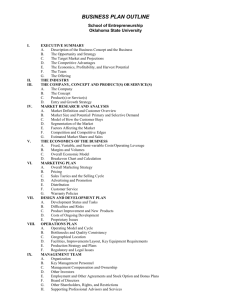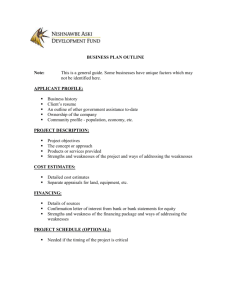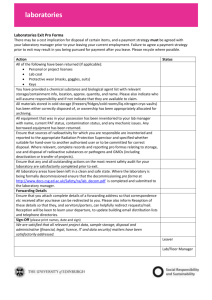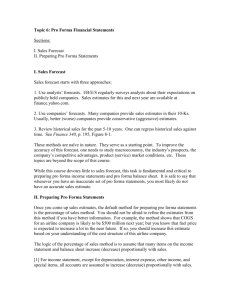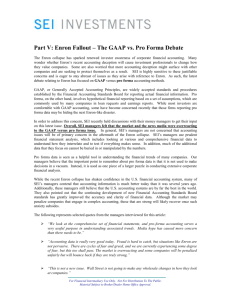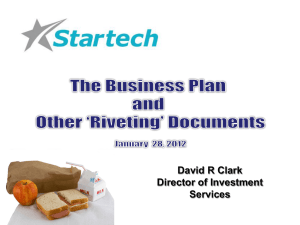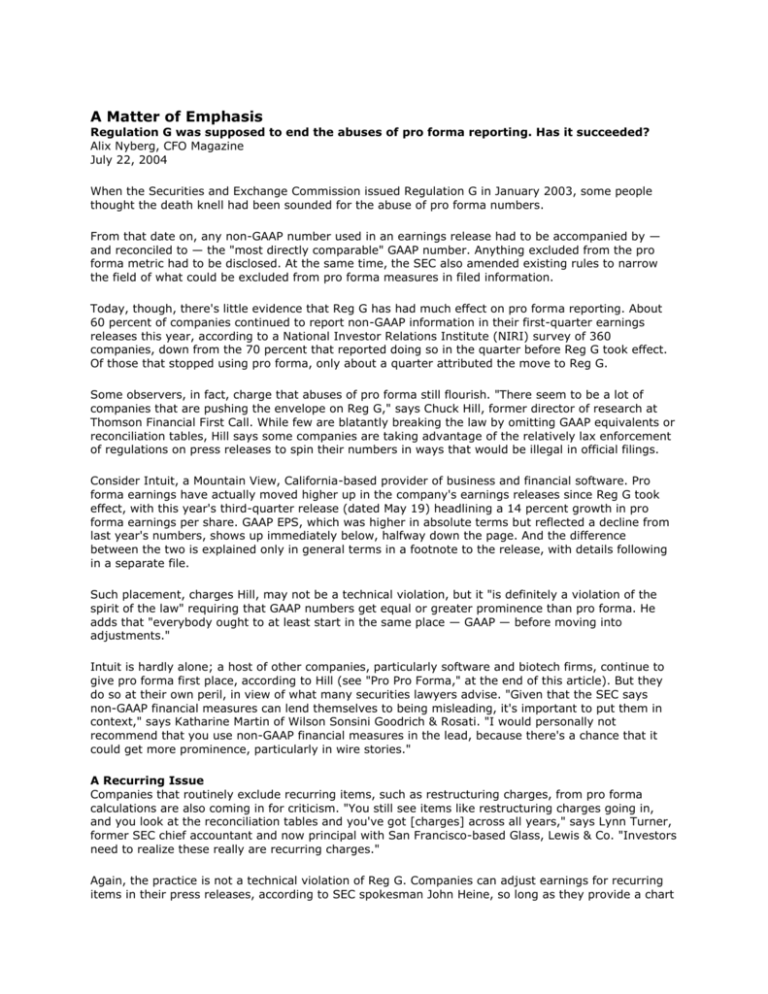
A Matter of Emphasis
Regulation G was supposed to end the abuses of pro forma reporting. Has it succeeded?
Alix Nyberg, CFO Magazine
July 22, 2004
When the Securities and Exchange Commission issued Regulation G in January 2003, some people
thought the death knell had been sounded for the abuse of pro forma numbers.
From that date on, any non-GAAP number used in an earnings release had to be accompanied by —
and reconciled to — the "most directly comparable" GAAP number. Anything excluded from the pro
forma metric had to be disclosed. At the same time, the SEC also amended existing rules to narrow
the field of what could be excluded from pro forma measures in filed information.
Today, though, there's little evidence that Reg G has had much effect on pro forma reporting. About
60 percent of companies continued to report non-GAAP information in their first-quarter earnings
releases this year, according to a National Investor Relations Institute (NIRI) survey of 360
companies, down from the 70 percent that reported doing so in the quarter before Reg G took effect.
Of those that stopped using pro forma, only about a quarter attributed the move to Reg G.
Some observers, in fact, charge that abuses of pro forma still flourish. "There seem to be a lot of
companies that are pushing the envelope on Reg G," says Chuck Hill, former director of research at
Thomson Financial First Call. While few are blatantly breaking the law by omitting GAAP equivalents or
reconciliation tables, Hill says some companies are taking advantage of the relatively lax enforcement
of regulations on press releases to spin their numbers in ways that would be illegal in official filings.
Consider Intuit, a Mountain View, California-based provider of business and financial software. Pro
forma earnings have actually moved higher up in the company's earnings releases since Reg G took
effect, with this year's third-quarter release (dated May 19) headlining a 14 percent growth in pro
forma earnings per share. GAAP EPS, which was higher in absolute terms but reflected a decline from
last year's numbers, shows up immediately below, halfway down the page. And the difference
between the two is explained only in general terms in a footnote to the release, with details following
in a separate file.
Such placement, charges Hill, may not be a technical violation, but it "is definitely a violation of the
spirit of the law" requiring that GAAP numbers get equal or greater prominence than pro forma. He
adds that "everybody ought to at least start in the same place — GAAP — before moving into
adjustments."
Intuit is hardly alone; a host of other companies, particularly software and biotech firms, continue to
give pro forma first place, according to Hill (see "Pro Pro Forma," at the end of this article). But they
do so at their own peril, in view of what many securities lawyers advise. "Given that the SEC says
non-GAAP financial measures can lend themselves to being misleading, it's important to put them in
context," says Katharine Martin of Wilson Sonsini Goodrich & Rosati. "I would personally not
recommend that you use non-GAAP financial measures in the lead, because there's a chance that it
could get more prominence, particularly in wire stories."
A Recurring Issue
Companies that routinely exclude recurring items, such as restructuring charges, from pro forma
calculations are also coming in for criticism. "You still see items like restructuring charges going in,
and you look at the reconciliation tables and you've got [charges] across all years," says Lynn Turner,
former SEC chief accountant and now principal with San Francisco-based Glass, Lewis & Co. "Investors
need to realize these really are recurring charges."
Again, the practice is not a technical violation of Reg G. Companies can adjust earnings for recurring
items in their press releases, according to SEC spokesman John Heine, so long as they provide a chart
reconciling the adjusted numbers to GAAP with the release. (Such adjustments to GAAP are only
prohibited in a company's 10-Ks and 10-Qs, which are covered by an amendment to regulations S-K
and S-B that was written concurrently with Reg G.)
However, the SEC continues to have wide latitude on what it considers misleading. Beginning an
earnings release with pro forma results and burying GAAP numbers, for example, "of course would be
a violation of Reg G," according to one SEC official. "Even before Reg G, we brought a case on that
issue," referring to the 2002 cease-and-desist order levied against Trump Hotels & Casino Resorts Inc.
for touting a pro forma profit without revealing that it excluded one-time charges but not one-time
gains until it made an official filing with the SEC.
With no SEC enforcement actions on Reg G to date, attorneys say the agency has so far been
sympathetic to the complexities of the law, which imposes detailed requirements such as posting
reconciliation tables on the corporate Website for any non-GAAP measures used in an earnings call
and giving the Website address to analysts before a presentation. "I think the SEC staff understands
this is complicated," says Martin, and generally gives companies in violation a chance to fix the
problem before imposing penalties. However, the agency "is definitely looking at Reg G compliance as
part of its periodic reviews."
To be sure, some companies have dropped non-GAAP measures altogether. But going cold turkey has
its disadvantages as well. Louis M. Thompson, NIRI's president and CEO, points out that most analysts
continue to make estimates on a non-GAAP basis. As a result, "some of the companies that go to
GAAP-only find themselves penalized by the market when they come in lower than First Call mean
[estimates]," making it seem like they missed their numbers.
Avoiding Confusion
To prevent such misunderstandings, Wellesley, Massachusetts-based PerkinElmer Inc. began including
First Call estimates in its earnings releases last fall, making reference to the estimate in the opening of
the release and providing it as a line item in its non-GAAP-to-GAAP reconciliation tables. "When the
media spit out 'PerkinElmer misses' because they were confused, we had to do something," says
company spokesman Dan Sutherby.
And many point out that pro forma numbers are still perfectly defensible, if used for the right reasons.
In fact, John Kenny, CFO of Boston-based document-management firm Iron Mountain Inc., says it was
at the SEC's request that the firm began to use the term "Adjusted EBITDA" for its primary earnings
metric three years ago. After a routine review of the highly leveraged firm's filings, says Kenny, the
SEC asked Iron Mountain to publish the adjusted form so that investors could better track the firm's
performance against its bond covenants using that metric.
When Reg G emerged, however, Iron Mountain's adjusted measure suddenly became unusable,
thanks to the new S-K/S-B amendment stipulating that neither GAAP nor pro forma results in filings
may exclude items if similar ones have been excluded in the previous two years, or are expected to be
excluded within the following two years. "The problem with Adjusted EBITDA was that some of the
things we were adjusting out — the foreign-exchange gains and losses, some merger-related costs,
and costs associated with refinancing — were occurring on a fairly regular basis," says Kenny.
As a result, the company dropped Adjusted EBITDA and introduced operating income before
depreciation and amortization (OIBDA) in both its releases and its filings. This measure does not
exclude any recurring charges, Kenny says, and is easier to reconcile to GAAP net income.
Given what seems to be a more judicious use of pro forma numbers — the spread between GAAP and
operating earnings for the S&P 500 narrowed to 11 percent for 2003 and dropped to 4 percent in the
first quarter of 2004 — and the rigorous disclosure that accompanies them, at least one longtime critic
of pro forma is happy with the changes Reg G has sparked. "What we do have today is absolutely
better than what we had before the regulation," says Turner, who dubbed pro forma earnings as
"everything but the bad stuff" during his tenure at the SEC. "Now at least people are getting
reconciliations to GAAP, and they're doing things consistently."
Alix Nyberg is a freelance writer based in Boston.
Pro Pro Forma
Some S&P 500 companies that continue to give prominence to
pro forma.
Company
Details for Most Recent Quarterly Release
BMC Software
"Net earnings excluding special items"
($40.8 million) leads the April 29 release,
and is the basis for the company's forward
guidance. GAAP earnings of $36.9 million
come later in the first paragraph, with the
difference explained only in an attached
table.
Chiron
Headlines pro forma earnings of 22 cents
per share, the 14 cents GAAP earnings
show up later in the body of the April 21
release. Despite a lengthy discussion of
the rationale for pro forma, the details of
what is excluded are left to the attached
table.
Hewlett-Packard
Puts $1.3 billion non-GAAP operating
profit ahead of $1.1 billion GAAP in the
May 18 release, but notes that both
include a one-time legal settlement and
follows with EPS based on net income.
Guidance given on non-GAAP-basis only.
PeopleSoft
Pro forma net income of $62 million
comes in the second paragraph of its April
29 release, with GAAP net income of $24
million following it, noting that the
difference is partially due to purchase
accounting adjustments for its J.D.
Edwards acquisition. The two are
reconciled in a table in the text.
Sabre Holdings
"Adjusted" EPS of 37 cents and GAAP EPS
of 31 cents both get a headline, but the
difference between the two is relegated to
page 8 of the April 22 release.
Sanmina
While noting in the first paragraph that
the reconciliations from GAAP to pro forma
are attached, Sanmina gives the 5 cents
per share pro forma gain a bullet point at
the top of its April 20 release, while
confining the 9 cents GAAP loss to a table
that follows pro forma results in the text.
Guidance given on a pro forma basis only.
Sources: Chuck Hill/Thomson Financial First Call; company Websites
© CFO Publishing Corporation 2004. All rights reserved.

